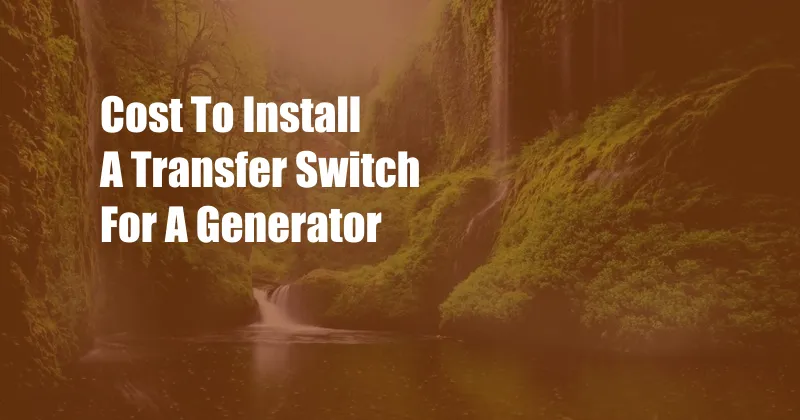
The Essential Guide to Transfer Switch Installation Costs for Generator Power
In the face of uncertain power grids and extreme weather events, investing in a backup generator can provide peace of mind. To seamlessly integrate your generator’s power into your home’s electrical system, a transfer switch is indispensable. But what exactly does it cost to install a transfer switch for a generator, and what factors determine these costs?
Understanding the factors influencing transfer switch installation costs is crucial. Let’s delve into these considerations and arm you with the knowledge to make an informed decision.
Unlocking the Importance of Transfer Switches
Transfer switches act as the gatekeepers between your generator and home’s electrical system. When the grid power falters, they automatically disconnect your home from the utility and connect it to the generator. This seamless transition prevents potentially hazardous back-feeding into the power grid and ensures safe and reliable backup power.
Transfer switches come in various forms, including manual and automatic. Manual transfer switches require you to manually operate the switch when power outages occur, while automatic transfer switches perform this task automatically, providing added convenience and peace of mind.
Unveiling the Cost Spectrum
The cost to install a transfer switch for a generator can vary depending on several factors, including:
- Type of Transfer Switch: Manual transfer switches typically cost less than automatic ones due to their simpler design and lack of automation features.
- Capacity: Higher-capacity transfer switches, measured in amps, can handle greater electrical loads and thus cost more.
- Installation Complexity: The complexity of the installation, such as the number of electrical circuits connected, can impact labor costs.
- Location: The location of the transfer switch installation can influence material and labor costs.
- Contractor Rates: Different electrical contractors may have varying rates for their services, affecting the overall installation cost.
Exploring the Range of Prices
The installation cost for a transfer switch can range from $500 to $2,000 or more. Manual transfer switches typically cost less, ranging from $500 to $1,000, while automatic transfer switches can cost between $1,500 and $2,000 or more depending on the capacity and features.
While these figures provide a general cost estimate, obtaining quotes from multiple licensed electricians is highly recommended to determine the most accurate and competitive price for your specific needs.
Tips for Cost-Effective Installation
To minimize installation costs, consider these tips:
- Choose a manual transfer switch: If you are comfortable manually operating the switch during power outages, a manual transfer switch can save you money.
- Select an appropriate capacity: Ensure the transfer switch’s capacity matches your generator’s output and the electrical load of your home.
- Get multiple quotes: Obtain estimates from different contractors to compare pricing and find the best value.
- Consider DIY installation: If you have electrical experience and are confident in your ability, you may be able to save on labor costs by installing the transfer switch yourself.
Expert Advice for Optimal Performance
To ensure a safe and efficient installation, follow the recommendations of experienced electricians:
- Hire a licensed electrician: Always engage the services of a qualified and licensed electrician for proper installation.
- Choose a reputable brand: Invest in a transfer switch from a reputable manufacturer with a proven track record of performance.
- Inspect the system regularly: Regularly inspect the transfer switch and generator to ensure they are in good working order.
Frequently Asked Questions
To provide you with further clarification, here are some frequently asked questions and their answers:
- Q: Is it essential to install a transfer switch for a generator?
A: Yes, a transfer switch is vital for safe and reliable backup power. It prevents dangerous back-feeding into the power grid and enables seamless integration of generator power into your home’s electrical system. - Q: Which type of transfer switch is better, manual or automatic?
A: Automatic transfer switches offer greater convenience by automatically switching to generator power during outages, while manual transfer switches require you to manually activate the switch. - Q: How long does it take to install a transfer switch?
A: Installation time can vary depending on the complexity of the installation, but typically takes a few hours to a full day.
Conclusion
Investing in a transfer switch for your generator is a wise decision to ensure seamless and safe backup power for your home. By understanding the factors that influence installation costs and following expert advice, you can make an informed decision and enjoy peace of mind knowing your home is protected during power outages.
If you have found this article informative and helpful, please share it with others who may benefit from this knowledge. Your feedback and engagement are greatly appreciated.